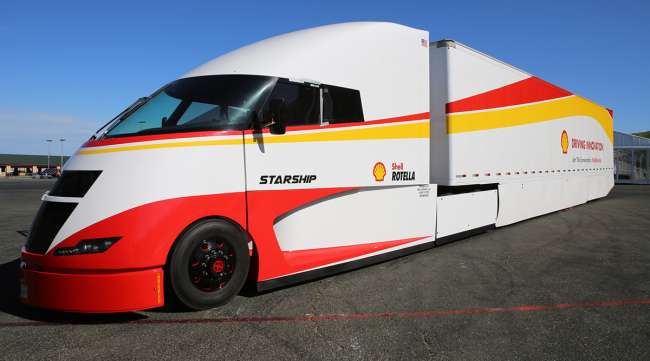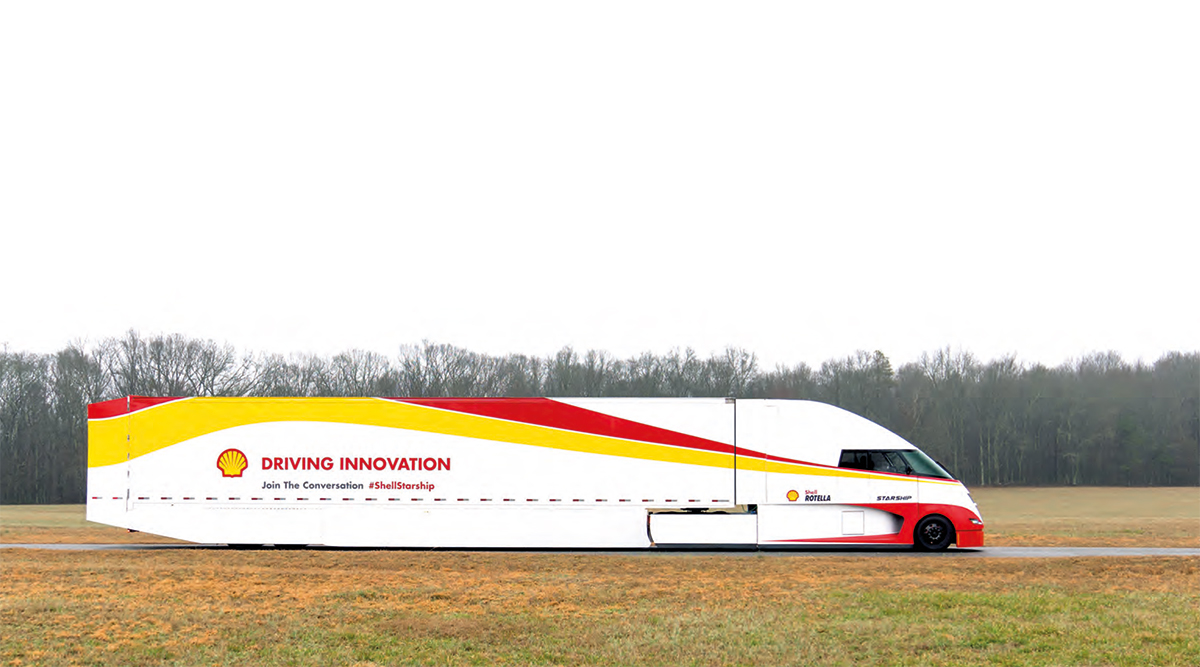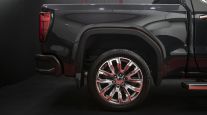Experimental Starship Initiative Truck Completes Cross-Country Test

A Starship landed in Jacksonville, Fla. But there were no aliens on board, just 40,000 pounds of reef-building material hauled cross-country in an experimental lightweight truck with streamlining everywhere. And within days of making the trip, it was shown June 5 at a daylong conference of industry officials and media at Jacksonville’s Prime Osborn Convention Center.
Called the Starship Initiative, the custom-built longhaul truck was in the spotlight — a long, sleek white bullet of a rig that traveled more than 2,300 miles across the southern United States, starting in San Diego on May 18 and ending in Jacksonville on May 24.
It’s the first time that a prototype Class 8 vehicle of this type, with combined fuel-saving technologies, has driven coast-to-coast in real-world trucking conditions, said Robert Mainwaring, Shell Lubricants Technology Manager for Innovation.
RELATED: Shell debuts fuel-efficient truck concept
Now, major manufacturers like Freightliner with its Evolution, and Peterbuilt’s Model 579 EPIQ, have adopted streamlined cabs with sleeker noses, plus more fuel-efficient engines, transmissions and tires. Many longhaul truckers add aerodynamic fairings to their cabs to clean up air flow.
Then there are the planned all-electric rigs like the Tesla Semi, with a 300- to 500-mile range, depending on equipment. The Nikola Motor Company also has a sleek commercial truck that uses a hydrogen-electric fuel cell and claims a range between 500 and 1,200 miles.
RELATED: Tesla’s new semi already has some rivals
So why build a new super-efficient diesel truck from the ground up?
“Indeed, Elon Musk has built a streamlined truck that’s electric. It hasn’t driven across the states. It hasn’t carried goods. There are huge amounts of things to be done to make that work,” Mainwaring said. “Ours is different. It’s about all of the technologies that already exist, bringing as many as we reasonably could in one place at one time.”
RELATED: Autonomous coast-to-coast Tesla trip past deadline, still coming
The Starship Initiative is all about lightness and air flow.
Designed and produced by the AirFlow Truck Company, owner Robert Sliwa’s efforts to build a more fuel-efficient truck began in 1983 by modifying his original cab-over truck to be more aerodynamic to hike his average 4.4 mpg. He soon got close to 10 mpg, so he started on a second, more aerodynamic Class 8 rig in 2009, called the BulletTruck, driving with his German shepherd, Kayla. Then came the Starship.
RELATED: AirFlow Truck Co., Toyota highlight Class 8 technology at Shell’s ‘make the future’ event
The truck’s cab is all carbon fiber, the body shell alone — without paint — weighing less than 300 pounds, strengthened with a race car-like roll cage.

Shell International
Hood and bumper are carbon fiber. There’s only a passenger-side door to get in. The grille has active shutters to maximize aerodynamics. The back of the 80-foot-long trailer has a fold-out aerodynamic boat tail for streamlined air flow. There are automatic extenders between cab and the front of the trailer to do the same, plus full carbon-fiber fairings over double-axle drive wheels.
There’s a full bellypan to better manage airflow, plus new DOT-approved side cameras that provided an-almost 180-degree view on each side of the truck for the driver.
“The fact it actually worked; it’s a small number of people working very, very hard for four years with so many things that could easily not integrate,” Mainwaring said. “For them to integrate and work for in essence two Trans-American runs — one to get to California, and the other to get here — that’s an amazing thing.
“It is so demanding to bring it all together that we ran out of time and literally came out of the shop, then went to the Truck Maintenance Show in Atlanta, then off to California to start the Trans-American run,” Mainwaring said.
Atop the cargo box is a 5,000-watt solar array that charges batteries and runs on-board components, including the custom digital dash and full LED lighting.
“The one thing that jumps out is the overall shape and design,” said Chris Guerrero, global brand manager of heavy-duty lubricants. “What you continuously heard as truckers drove by, the more tame version was, ‘What the hell was that?’ Hands down, it got attention everywhere it went.
RELATED: Daimler throws shade at Tesla as truck rivalry heats up
“In terms of innovation and systems, if you look at the auxiliary power supply, we have the solar array; it’s an innovative system,” Guerrero said. “The benefit is we get to generate our own electricity to run some of the electrical systems and a/c. You have to store those batteries and they weigh something. So you take away some of the weight with the carbon-fiber design of the cab so you have room and don’t add weight overall.”
Under the streamlined hood is a 2017 Cummins X15 six-cylinder diesel engine with 400 horsepower and 1,850 pound-feet of torque, hooked to a recalibrated Eaton 18-speed transmission. There’s also a 100-gallon diesel tank. The engine gets help starting from a 2-volt super-capacitor, while a hybrid electric axle system gives a power boost while climbing grades.
Cross-country, the Starship truck attained 178.4 ton-miles per gallon for freight ton efficiency, an almost 248% improvement over the North America average freight-ton efficiency of 72 ton-miles per gallon for trucks, Shell said.
The final total truck and cargo weight was almost 28% heavier than the average gross weight of 57,000 pounds for a U.S. on-highway Class 8 truck. Total average fuel economy was 8.94 mpg vs. the average for transport trucks at 6.4 mpg, the best being 10.2 mpg.
The cross-country drive was also a test of Shell’s new Rotella T6 Ultra 5W-30 full synthetic engine oil.
So what’s on the side of the truck is an invitation, Mainwaring said, to “join the conversation” — talk about using current technology to help reduce fuel use and emissions.
“We want to have conversations with all of the world’s OEMs, not just the truck sector but the automotive sector,” Mainwaring said. “Obviously, we want to do business with them, collaborating so they are thinking using our lubricants as a design component. The lubricant is reducing friction, enhancing efficiency or enabling other technologies that help efficiency.”
As for what’s next, Guerrero said the Starship heads next weekend to the 36th annual Shell Rotella Super Rigs event in Raphine, Va., with a truck parade, fireworks display and other events.
“After that, back to the drawing board and shop to prioritize areas that we learned about,” he said. “On the trip, we got a lot of data that we will sort through and figure out areas where we want to make tweaks. There are a few things we want to play with, and then we want to get it back on the road and try it again.”
Distributed by Tribune Content Agency, LLC




